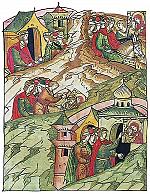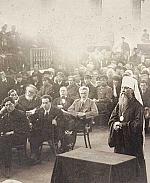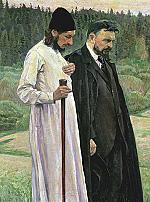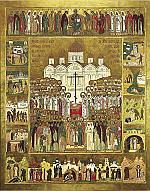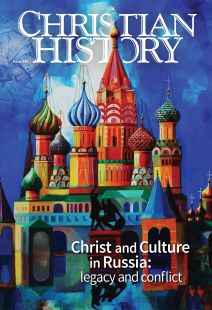Love as an act of rebellion

[above: Wassilij Maximowitsch Maximow, Sick Husband—Tretyakov Gallery / public domain, wikimedia]
“When cruelty is the norm, love is an act of rebellion.” This thesis, applied to Christ’s response to the Grand Inquisitor in The Brothers Karamazov (1880), belongs to Dostoevsky scholar Michael Ossorgin. In the novel the Inquisitor has just condemned Christ to death; without a word, Christ kisses him. This breathtaking alternative ethic also applies to the best traditions of Orthodox Christian thought as reflected in nineteenth-century Russian literature.
Alternative to live by
Cruel and arbitrary exercise of power has been an identifying mark of Russia’s governing elites for a millennium. The current fusion of military aggression, human rights abuse, and religious fervor uncannily resembles the fusion of a brutal political agenda with atheistic fervor under communism. Little wonder that Russian literary creators committed with some urgency to devising more spiritually healthy alternatives to live by.
Exemplary here are three very different prose writers from the second half of the nineteenth century: Fyodor Dostoevsky (1821–1881), Leo Tolstoy (1828–1910), and Nikolai Leskov (1831–1895). Their fictional heroes are inconstant seekers; their own lives, too, were neither easy nor consistent. All were raised Russian Orthodox, and each offered his own corrective to official ecclesiastical practices. These correctives varied profoundly.
Dostoevsky, in his journalism, recommended military action against the Ottoman Empire to recapture the holy city of Constantinople. In his novels, however, he championed a very different ideal, a compassionate panentheism (the belief that the divine permeates every aspect of the universe), which drew ire from conservative Orthodox critics. Tolstoy, pacifist, Christian anarchist, and anticlerical theist, was the loudest, most stubborn rebel. He rejected the authority of the Orthodox Church and disavowed both the Trinity and the Resurrection. For ridiculing the holy liturgy in his final novel, Resurrection (1898), the church effectively excommunicated Tolstoy in 1901.
Leskov, who descended from a line of clergymen and began his career as a self-taught journalist, combined expertise in Orthodox doctrine with hands-on knowledge of the many dazzling varieties of Russian religious experience. All three writers were deeply invested in understanding the workings of love.
Two sources of inspiration were of cardinal importance to this love project. The first was traditional folk belief, Russia’s peculiar blend of Orthodoxy with pre-Christian ritual known as dvoeverie, or “dual faith.” The artistic elite began to celebrate folk belief as a key aspect of Russian national identity in the nineteenth century, under the influence of German Romanticism.
Native Russian paganisms tended not to be maritime but continental, tied to the soil, rivers, and forests. They were less anthropomorphic than the Greek and Roman pantheon. There was no single goddess of female beauty, for example, only of grass, birch trees, ponds, and swamps—and unlike Venus or Aphrodite, she did not need a face. Beauty was not jealous, but fertile and patient. The good was cyclical and seasonal.
The second inspiration was less affirmative. These writers were, overall, indifferent to reproducing that staple of the European novel, the bourgeois love plot, so obsessed with carnal naughtiness and so hungry for a happy marriage at the end. That narrative was more often parodied than followed. In its place Russian writers managed to invest the far more complex virtues of caritas and agape with the irresistible appeal and mystery of eros.
These three forms of love can overlap, but to grasp their potential for rebellion, consider these distinctions. Eros, for the British author C. S. Lewis, is a “need-love,” by no means identical with carnal sexuality but usually marked by desire for a discrete, incarnated other. Eros can be generous and joyous, Lewis insisted, if not taken too seriously or made too “rapt, intense, and swoony-devout.”
Caritas is charity—but more an evaluative attitude or worldview than a concrete act; in the words of Thomist philosopher Josef Pieper, it is a “readiness to pay something for the union with God.” Agape, conventionally opposed to eros, is “gift-love” that works altogether outside commercial economies, undemanding and unselfish, offered without expectation of reward.
Scandals of eros and agape
In their quest for a love plot devoid of sexual possessiveness and independent of official institutions, Russian writers saw the Orthodox Church, subordinated to the state, as an uneasy ally and at times even an enemy. Established authority, with its hierarchy and wealth, inevitably fell prey to the temptations of judgment and violence. By contrast weakness and solitary wandering, being vulnerable, were morally invincible. Love was unpower.
Literary plots built around scandals caused by disobedient eros are commonplace in all cultures. Dostoevsky, Tolstoy, and Leskov could work with those plots too—Tolstoy’s Anna Karenina has a classically erotic “swoony-devout” heroine—but many of their masterpieces revolve around scandals caused by caritas and agape.
On the material plane, agape-love can seem unbeautiful, barren, bereft of family. Russian writers, however, were fond of redefining fertility, expanding kinship categories, and uncovering alternative forms of ecstasy. The resources of dvoeverie were their toolkit. Nature was “profane matter” but also holy. Dual faith balanced “praying up” (to a heavenly Father or a resurrected Christ) with “praying down” (to Mother Earth).
By praying up, mediated by the sign of the cross, one accesses the ideal—but risks losing touch with matter. By praying down, helped by incantations and charms, one is promised a reunification with the earth; burying a dead body meant to reconsecrate it, to plant it in the womb of its original mother. But the organic world was rife with base appetites and seductions. No space was neutral: it was either protected (by a pagan spirit or a patron saint), or it was unprotected. If unprotected it was open to dark spirits, collectively called the “unclean force.” These spirits were more mischievous than evil. They could be appeased and bribed with gifts. Their power lay in their multitude and smallness.
Writers made much of these petty devils, at times keeping them tiny, at times bloating them up to human size as in the shabby gentleman who visits Ivan Karamazov in his nightmare. But Russian demons rarely achieved the monumental stature of Dante’s Lucifer or Milton’s Satan. The moral landscape of dual-faith plots was usually less melodramatic and more prosaic than those lofty biblical trials. In our everyday weakness and quest for love, do we pray up or down? Out of the immense output of these three writers, only select scenes from each are evoked here, focusing on the prayerful act.
The body of Christ
In Dostoevsky’s Crime and Punishment (1866), reverent moments often occur across thresholds, eye-to-eye, in the horizontal leap of a divine spark. But the wisdom of bowing down, at once deeply Orthodox and pre-Christian, permeates the novel. Sonya (Sophia), the unstained prostitute who saves Raskolnikov, makes only one nonnegotiable demand: that the murderer confess his sin downward, asking the earth’s forgiveness by kissing the dirty public square. Only then will healing begin. Descent before ascent is the proper Christian sequence, of course, but the novel scarcely attends to the upward turn, to the sinner’s pleas for divine guidance. Christian dogma is active in this novel, but more as Scripture (for instance, Sonya’s reading of the raising of Lazarus, an act of devotion that Raskolnikov mocks).
The Brothers Karamazov is likewise full of symbolic bows and downward prayer. Book six, “The Russian Monk,” takes place in protected space: the Elder Zosima’s life retold from the loving perspective of his disciple Alyosha. Zosima is an inspired clerical example of dual faith, balanced between the higher ideal of an all-forgiving Jesus and an equally sacred cyclical principle, rooted in nature and revealed to him at the time of his brother Markel’s death.
It is the Christian envelope, however, that proves transfigurative. Literary scholar Paul Contino, in his study of Dostoevsky’s “incarnational realism,” notes that Zosima might have been criticized for being “thin on Orthodox practice,” but his entire life and worldview are implicitly rooted in the Incarnation, with “the church as Christ’s body.” Zosima’s trademark is to bow down to sinners, to the earth, eventually to be buried in that earth and even to rot publicly in it. This is no scandal, Alyosha gradually comes to see. It is sacramental.
Arguably Leo Tolstoy’s worldview was dual faith throughout his writerly career. He prayed down to nature, fertility, physical strength, peasant labor, and then (after his spiritual crisis in the late 1870s) attempted—with uneven success—to pray up to a disembodied ideal devoid of the “animal principle” altogether. An intolerance of civilization’s social rituals and a reverence for what is palpably, ecologically agricultural saturate his novels. In Anna Karenina (1878) this is the “Konstantin Levin” option, the man who works the soil as against his bookishly abstract brother, Sergei Koznyshev. In War and Peace (1867), this ethos is embodied in the peasant Platon Karataev, whom Pierre Bezukhov befriends in a French prisoner-of-war camp. Both Levin and Bezukhov eventually consummate a romantic love plot. But familial love, storge, with its focus on prosaic interactions and cyclical generations, quickly crowds out scenes of conventionally romantic eros.
As a Christian thinker, Tolstoy was part radical Protestant and part rebellious gnostic. In the name of what he called “reasonable consciousness,” he rejected the Trinity, the sacraments, original sin, redemption, salvation, final judgment, and all other “supernatural ways of caring for men.” With those excisions can we even speak of a “praying up” in a Christian cosmos? To some extent we can, if we apply to Tolstoy the same incarnational vision that Paul Contino confers on Dostoevsky’s Elder Zosima.
Consider Tolstoy’s tiny 1859 story, “Three Deaths.” The first death is that of a noblewoman fleeing Russia for an illusory cure in Europe. She is in consumption, in denial, but, being wealthy and pampered, she is trapped in profane matter. She can neither let go nor pray upward and thus meets a miserable end.
The second death is that of a coachman at a waystation where the noblewoman’s carriage makes a stop. This peasant coachman, Fyodor, accepts the life-death transition. When the young fellow driver, Sergei, asks the dying coachman for his boots, Fyodor agrees—but on condition that Sergei erect a cross over his grave. Eventually Sergei remembers his promise and one morning goes into the forest to find the right tree.
This is the third death and the best. It is not pain free. The natural universe is sentient. The tree knows it is dying as the axe cuts into it; it shudders and its roots tremble with fear. The final note is one of jubilation, however, as more sunlight fills the forest over the fallen tree, which will rise again as a cross. This scene reveals dual faith at its most radiant: Christian self-emptying not from a cramped personal point of view but as part of a larger cosmos, from the perspective of nature itself.
Leskov’s wide lens
There were darker sides to dual faith, however, and here Nikolai Leskov is a rich resource. In his youth Leskov had worked as a business agent for his uncle and traveled extensively throughout the Russian Empire. This diversity of impressions decentered him, discouraging the sort of blanket pronouncements about “the Russian people” so common in Dostoevsky and Tolstoy, each of whom was a Romantic in his own way. Leskov was an intimate eyewitness to all social classes—nobles, merchants, peasants, bureaucrats, the clergy, sectarian Old Believers—but scandalously refused to commit to any reigning political ideology.
His “Enchanted Wanderer” (1873) is a classic frontier adventure tale, but without the usual aggressive, self-assertive hero. Instead the protagonist wanders from one captivity to the next, first sampling life in the army, then being hobbled by the Tartars, finally finding refuge in a monastery.
“Episcopal Justice” (1877) concerns the forcible conscripting of underage Jewish boys into the Russian military in Kyiv. Both the narrator (a low-level clerk) and the Orthodox Christian metropolitan are routinely anti-Semitic state servitors, yet they stumble into helping an agonized Jewish bookbinder save his son. As a chronicler of institutions where cruelty was the unmarked norm, Leskov can shock his readers with actual—even if accidental—acts of reconciliation
and love.
A shapeshifter
One such shocking act unfolds in Leskov’s 1885 tale “The Spook.” The narrator is a young upper-class boy, brought up on holy Scripture but fascinated by folk belief: wood demons, water-mill spirits, swamp sprites.
Along with his family, their serfs, and the entire village, he assumes that the local recluse, Selivan, who lives in a rundown inn off the main road, is in league with the unclean force. Every misdoing or mishap is attributed to him. When facts don’t add up, rumor and magic pitch in: Selivan must be a shapeshifter, the villagers say, he commits crimes but cannot be caught because he turns into a boar, rooster, rat, wagon-wheel, or roadside post.
Selivan lifts the narrator and his younger brother onto his shoulders and out of a swamp when their cart overturns, and the village accuses him of causing the accident. In the final episode, a blizzard forces a wealthy relative to take emergency refuge in Selivan’s inn. So certain are the travelers that they will perish violently in this unprotected place that come dawn they rush out, forgetting their moneybox. Selivan’s theft is assumed—until he turns up, breathless, at the police station. “You forgot your little coffer.” Selivan refuses the reward due him by law and pressed on him by the grateful travelers. “There’s no need. . . . I don’t need what isn’t mine.”
Only pagan logic insists on contracts and laws. This is Christianity winning with the right tools: not by the sign of the cross to keep devils at bay (a gesture still on the superstitious side of dual faith) but by the deeds of a Russian pravednik, a “righteous person” who does good absolutely regardless. Selivan is relieved that the townspeople no longer fear him, but for past injuries he seeks neither retribution nor justice. The final voice belongs to the local Oryol priest: “Christ lit up for you the darkness. . . . It was not Selivan who was the spook, but you. . . . His face seemed dark to you, because your eye was dark.”
Leskov in this late story achieves the nonjudgmental moral texture that Tolstoy and Dostoevsky, in their novels, developed through far more elaborate philosophical structures. Selivan’s love is an act of rebellion against cruel political norms, which in Russia—then as now—were abetted by a compromised, hierarchical church.
But the prayerful orientation of the outcast Selivan is neither up nor down. It is across, a love-laden response to an immediate needy other in the present. Like Dostoevsky’s Elder Zosima, and (with some pantheistic adjustment), also like Tolstoy’s tree that becomes a cross, Leskov’s pravednik Selivan takes our breath away, a luminous example of Russian Orthodox personalism, which values above all the dignity of the human being in social and divine relation. Where cruelty is power, love is an act of rebellion. CH
By Caryl Emerson
[Christian History originally published this article in Christian History Issue #146 in 2023]
Caryl Emerson is A. Watson Armour III University Professor Emeritus of Slavic Languages and Literatures at Princeton University and author or editor of a number of books including The Cambridge Introduction to Russian Literature.Next articles
Christian History TImeline: Christ and culture in Russia
Selected events from this issue and their context. (Underlined items represent the rise to power of some major political leaders.)
the editorsSupport us
Christian History Institute (CHI) is a non-profit Pennsylvania corporation founded in 1982. Your donations support the continuation of this ministry
Donate



